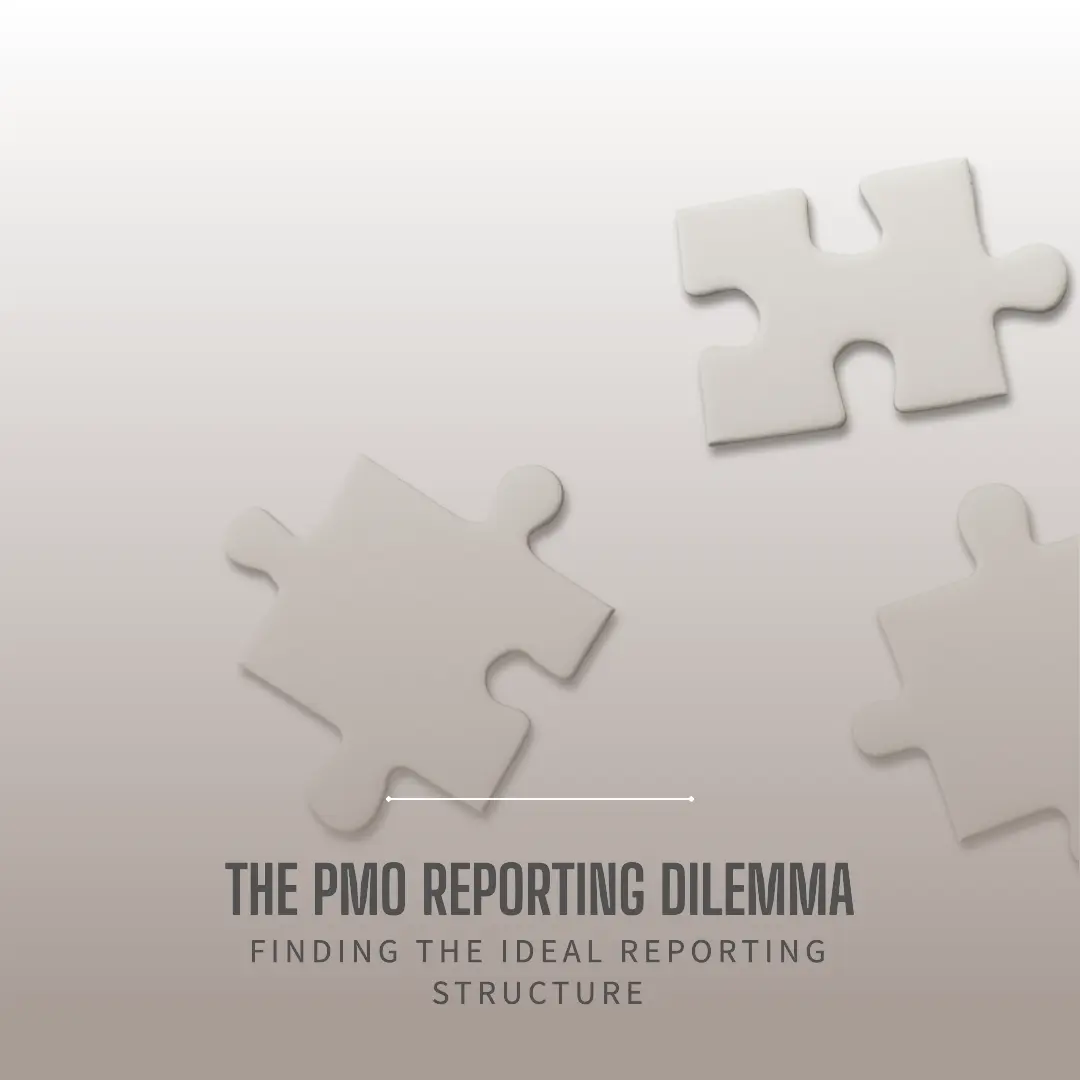To find out how Artificial Intelligence is changing the Project Management landscape, you may enjoy reading this article https://www.shaunstoltz.com/did-artificial-intelligence-just-change-everything-about-project-management/
I. Introduction
Hello, fellow project management enthusiasts! If you’ve found yourself in the challenging and exciting world of Project Management Offices (PMOs), you’re probably well aware of the critical role that effective reporting structures play in an organization’s overall success. With countless projects, various stakeholders, and a plethora of KPIs to keep track of, finding the right reporting structure can feel like searching for the proverbial needle in a haystack. But fear not! I’m here to help guide you through this maze and provide some clarity on the subject.
In this blog post, we’ll dive into the various reporting structures commonly used by PMOs, discuss the pros and cons of each, and offer some practical guidance on how to establish an effective reporting relationship. By the end of our journey together, you’ll be well-equipped to make informed decisions about which reporting structure best suits your organization’s unique needs and preferences. So, grab a cup of your favorite beverage, get comfortable, and let’s get started on unraveling the PMO reporting dilemma!
II. The Various Reporting Structures for PMOs
Before we dive into the nitty-gritty of reporting structures, let’s make sure we’re on the same page. A reporting structure essentially determines who a PMO reports to within an organization. It’s the chain of command that influences decision-making, resource allocation, and overall project direction. Now that we’ve got that covered, let’s explore the different types of reporting structures you might encounter in the wild world of PMOs.
A. Definition of reporting structures
Reporting structures vary from organization to organization, but they generally fall into one of these five categories:
- Direct reporting to executive sponsor
- Reporting to the functional manager
- Reporting to a central PMO
- Hybrid reporting structure
- Matrix reporting structure
Let’s take a closer look at each of these reporting structures and what they mean for your PMO.
B. Types of reporting structures
- Direct reporting to executive sponsor: In this structure, the PMO reports directly to a high-ranking executive, such as the CEO or a divisional head. This can lead to increased visibility for the PMO and ensure that projects align with the organization’s strategic goals.
- Reporting to the functional manager: Here, the PMO reports to a functional manager, such as the head of a specific department (e.g., finance, IT, or marketing). This structure can facilitate better integration of the PMO within the department it serves, but it might limit its influence on cross-functional projects.
- Reporting to a central PMO: In organizations with multiple PMOs, they may report to a central PMO or a PMO director. This centralized approach can create consistency across the organization and promote standardization of project management practices.
- Hybrid reporting structure: The hybrid approach is a blend of the previous structures. For example, a PMO might report to both an executive sponsor and a functional manager. This can provide the benefits of multiple reporting lines while mitigating the potential drawbacks.
- Matrix reporting structure: In a matrix setup, the PMO reports to multiple stakeholders across the organization, such as functional managers and project sponsors. This structure can be effective for organizations with complex projects that span multiple departments, but it may also create challenges in terms of decision-making and accountability.
Each of these reporting structures has its own unique advantages and drawbacks, and it’s crucial to understand them before deciding which one is best for your organization. In the next section, we’ll delve into the pros and cons of each reporting structure, giving you the information you need to make an informed decision. Stay tuned!
III. Pros and Cons of Each Reporting Structure
Now that we’ve familiarized ourselves with the various reporting structures for PMOs, it’s time to weigh the benefits and drawbacks of each. As you read through this section, think about how each structure aligns with your organization’s needs and objectives. Remember, there’s no one-size-fits-all solution, so it’s all about finding the right fit for your unique situation.
A. Direct reporting to executive sponsor
- Pros:
- High visibility for the PMO within the organization, leading to increased influence and support
- Direct access to top-level decision-makers, ensuring projects align with strategic goals
- Faster decision-making, as there are fewer layers of bureaucracy to navigate
- Cons:
- Potential for the PMO to become isolated from other departments or functional areas
- Executive sponsor may not have sufficient time or expertise to provide ongoing guidance and support
B. Reporting to the functional manager
- Pros:
- Better integration of the PMO within the department it serves, resulting in improved collaboration and resource allocation
- Functional manager may possess a deep understanding of the department’s needs and priorities
- Cons:
- Limited influence on cross-functional projects, as the PMO’s scope is primarily restricted to its own department
- Possible conflicts of interest, as the functional manager may prioritize departmental needs over broader organizational objectives
C. Reporting to a central PMO
- Pros:
- Standardization of project management practices across the organization, resulting in increased efficiency and consistency
- Central PMO can act as a hub for knowledge sharing and best practices among individual PMOs
- Cons:
- Potential for the central PMO to become overwhelmed by the demands of multiple PMOs, leading to delays or bottlenecks in decision-making
- Risk of a “one-size-fits-all” approach, which may not account for the unique needs and challenges of individual PMOs
D. Hybrid reporting structure
- Pros:
- Combines the benefits of multiple reporting lines, such as increased visibility and better integration within departments
- Allows for greater flexibility and adaptability, as the structure can be tailored to the organization’s specific needs
- Cons:
- Possible confusion or conflicts over roles and responsibilities, as PMO staff may have multiple reporting lines
- Potentially more complex and difficult to manage, as it requires careful coordination and communication among stakeholders
E. Matrix reporting structure
- Pros:
- Encourages cross-functional collaboration and resource sharing, as PMOs report to multiple stakeholders across the organization
- Can effectively support complex projects that span multiple departments or functional areas
- Cons:
- Challenges in decision-making and accountability, as PMO staff may receive conflicting guidance from different stakeholders
- Risk of competing priorities and resource allocation issues, as stakeholders may have different objectives and expectations
With this comprehensive overview of the pros and cons of each reporting structure, you’re well on your way to making an informed decision about which one is right for your organization. In the next section, we’ll discuss the factors to consider when choosing the ideal reporting structure and provide some practical tips for establishing an effective reporting relationship. Keep reading!
IV. Factors to Consider When Choosing the Ideal Reporting Structure
As we’ve seen, each reporting structure comes with its unique set of advantages and challenges. But how do you decide which one is the best fit for your organization? It’s all about taking a step back and considering the bigger picture. In this section, I’ll walk you through the key factors to keep in mind when evaluating different reporting structures for your PMO.
A. Organizational culture
Think about your company’s culture and how it might influence the effectiveness of different reporting structures. Is your organization highly centralized, with decision-making concentrated at the top? A direct reporting structure might work well in this context. On the other hand, if your company values cross-functional collaboration, a matrix or hybrid structure could be a better fit.
B. Project complexity
Consider the complexity of your organization’s projects and how this might impact the reporting structure. For instance, if you’re managing highly complex, cross-functional projects, a matrix structure might be more suitable, as it fosters collaboration among different departments. Conversely, if your projects are relatively simple and confined to a specific department, a functional reporting structure may be more appropriate.
C. Company size
The size of your organization can also play a role in determining the ideal reporting structure. Larger organizations with multiple PMOs may benefit from a central PMO structure to ensure consistency and standardization. On the other hand, smaller organizations with fewer projects and resources might find a direct or functional reporting structure to be more efficient and manageable.
D. Resource availability
Take stock of the resources available to your PMO, including personnel, expertise, and technology. A reporting structure that allows for effective resource allocation and support will be more likely to succeed. For example, if your organization has limited resources, a centralized or direct reporting structure might help ensure that projects receive the necessary attention and support from top-level decision-makers.
E. Strategic alignment
Finally, consider how each reporting structure aligns with your organization’s strategic goals and objectives. The ideal reporting structure will help your PMO contribute to the achievement of these goals while minimizing potential conflicts and inefficiencies. For example, if your company prioritizes innovation and cross-functional collaboration, a matrix or hybrid reporting structure might be more conducive to achieving these aims.
By carefully considering these factors, you’ll be well on your way to finding the ideal reporting structure for your organization’s PMO. But once you’ve chosen a structure, how do you establish an effective reporting relationship? Fear not, for in the next section, I’ll share some practical tips that will set you on the path to success. Let’s dive in!
V. Tips for Establishing an Effective Reporting Relationship
You’ve done the hard work of evaluating different reporting structures and selecting the one that best aligns with your organization’s needs and goals. Congratulations! Now it’s time to turn your attention to building a strong and effective reporting relationship. Here are some practical tips to help you hit the ground running:
A. Clear communication channels
Establishing clear lines of communication is essential for any reporting relationship. Make sure everyone knows who they need to report to and how they should share information. This might involve setting up regular meetings, creating shared online spaces for collaboration, or implementing a standardized reporting format. Whatever methods you choose, make sure they are accessible and user-friendly for all stakeholders.
B. Regular reporting cadence
Consistency is key when it comes to reporting. Set a regular cadence for reporting on project progress, milestones, and challenges. This could be weekly, monthly, or quarterly, depending on the complexity and duration of your projects. A regular reporting schedule helps ensure that all stakeholders stay informed and engaged, which in turn fosters a sense of accountability and ownership.
C. Consistent metrics and KPIs
To effectively measure and evaluate project performance, it’s crucial to establish consistent metrics and key performance indicators (KPIs) that align with your organization’s goals. Work with your team and stakeholders to identify meaningful KPIs and establish a process for tracking and reporting on them. This will enable you to demonstrate the value of your PMO and make data-driven decisions about resource allocation and project prioritization.
D. Training and support for stakeholders
To foster a culture of collaboration and continuous improvement, invest in training and support for stakeholders involved in the reporting process. This might include workshops on project management best practices, software training, or coaching on effective communication techniques. Empowering stakeholders with the skills and knowledge they need to contribute to the reporting process will enhance the overall effectiveness of your PMO.
E. Periodic evaluation and adjustments
Lastly, remember that no reporting structure is set in stone. Regularly evaluate the effectiveness of your chosen reporting structure and make adjustments as needed. This might involve soliciting feedback from stakeholders, conducting internal audits, or benchmarking against industry best practices. By staying flexible and adaptable, you’ll be better equipped to navigate the inevitable changes and challenges that arise in the dynamic world of project management.
With these tips in hand, you’re now ready to establish an effective reporting relationship that will set your PMO up for success. Remember, finding the ideal reporting structure is just the beginning – it’s the ongoing commitment to communication, collaboration, and continuous improvement that will ultimately determine your PMO’s impact and value. Best of luck on your journey, and happy reporting!
VI. Conclusion
We’ve come a long way together, my fellow PMO enthusiasts! From exploring the various reporting structures and their pros and cons, to considering the factors that influence the ideal reporting structure for your organization, we’ve covered a lot of ground. And with the practical tips for establishing an effective reporting relationship under your belt, you’re now equipped to navigate the world of PMO reporting with confidence and skill.
In conclusion, remember that the journey to finding the perfect reporting structure is unique for every organization. It’s essential to take a step back, consider your organization’s specific needs and goals, and be open to adapting and refining your approach as circumstances change. Embrace the challenge, learn from your experiences, and keep striving for excellence in project management.
As you embark on this exciting adventure, I wish you the very best of luck. May your PMO reporting journey be filled with valuable insights, meaningful connections, and, most importantly, a whole lot of fun! So, here’s to your success and the bright future of your organization’s PMO.
Find out more about Shaun Stoltz https://www.shaunstoltz.com/about/
This post was written by an AI and reviewed/edited by a human.



